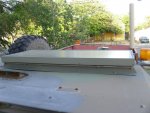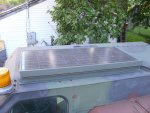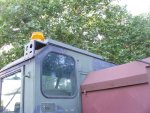Jones
Well-known member
- 2,237
- 83
- 48
- Location
- Sacramento, California
OK, OK... two wires; one red, one black-- how hard can wiring one be, right?
Solar chargers; from the battery maintainers like Solargizers to the full-blown solar battery charger panels have two wires, one for the pos and one for the neg battery terminals.
My question is: Is there a reason to run both leads to the battery or could you get the same results by running the neg to the nearest ground and the pos to the battery pos post or a pos always hot terminal in the vehicle's wiring.
This panel was scrapped because it doesn't meet the current solar panel efficiency rating requirements.
It's a good, fully functional 12 vdc, 10 amp (120 watt) unit complete with it's own voltage regulator.
Who says "Going Green" doesn't have it's benefits.
I bent up some mounting brackets and am getting it installed on the baby HEMTT.
I may not be able to drive the baby HEMTT right now but with this set-up, I can sure see to it that the batteries won't go dead.
Solar chargers; from the battery maintainers like Solargizers to the full-blown solar battery charger panels have two wires, one for the pos and one for the neg battery terminals.
My question is: Is there a reason to run both leads to the battery or could you get the same results by running the neg to the nearest ground and the pos to the battery pos post or a pos always hot terminal in the vehicle's wiring.
This panel was scrapped because it doesn't meet the current solar panel efficiency rating requirements.
It's a good, fully functional 12 vdc, 10 amp (120 watt) unit complete with it's own voltage regulator.
Who says "Going Green" doesn't have it's benefits.
I bent up some mounting brackets and am getting it installed on the baby HEMTT.
I may not be able to drive the baby HEMTT right now but with this set-up, I can sure see to it that the batteries won't go dead.
Attachments
-
85.4 KB Views: 47
-
80.5 KB Views: 51
-
101.5 KB Views: 46





